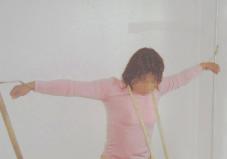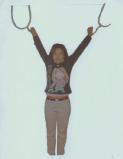Tortures Used in the Persecution of Practitioners: Dislocation, Hanging, Suffocation (Re-enactment Photos)
(Clearwisdom.net) Since July 20, 1999, Falun Gong practitioners in China have suffered the most brutal and cruel persecution ever in recorded history. The torture measures endured by practitioners in various prisons, forced labor camps and detention centers are repulsive. The following are re-enactments by a practitioner who personally suffered the tortures. The descriptions provide a more detailed explanation of each situation.
1. One torture used to persecute practitioners at Bailuquan Police Station in Luquan County, Shijiazhuang City, Hebei Province
 |  |
Explanation about the torture:
The practitioner was handcuffed to a ring on the wall, with arms outstretched and the body forming the shape of a cross. One end of a rope was tied to the practitioner's neck and the other end was fixed to the ground two meters away. A policeman stepped on the rope, which felt like "separating the body with five horses." The handcuffs cut into the wrists, causing them to bleed. Two policewomen scratched the practitioners' ears and face with burrs, which was extremely painful and itchy.
2. Tortures used to persecute practitioners at Wanjia Forced Labor Camp in Harbin, Heilongjiang Province
Falun Gong practitioners abducted to Wanjia Forced Labor Camp were first searched and then ordered to write the "Three Statements" renouncing their belief. Because they all refused, they were forced to squat on the brick floor, one person per each 40 square-centimeter brick, with their hands behind them. Anyone who moved or went beyond the lines of their brick was beaten or cursed. They were forced to squat from 5:00 a.m. to midnight. Some practitioners' legs and feet became swollen, and they were unable to walk for several days, while others hurt their backs. Some practitioners fell into a coma during the torture. This torture was called "yanma." Practitioners were also forced to watch a video slandering Falun Dafa. They were only allowed to relieve themselves twice in 24 hours. If they still refused to write the "Three Statements," they were forced to sit on the "Iron Chair," another torture technique, and were shocked by three or four police with several electric batons. When the police still couldn't achieve their goal, they used the "Handcuff Hanging Torture," in which practitioners were hung in the air, feet off the ground, suspended by handcuffs holding their arms behind their backs. This is illustrated in the third photo, but using rope instead of handcuffs. In Wanjia Forced Labor Camp the "Handcuff Hanging Torture" entailed handcuffing the wrists to a double bed with feet barely touching the ground, and then the bed is pulled apart sideways, causing the handcuffs to cut into the flesh.
Police shocked steadfast practitioners with electric batons for extended periods, burning many holes in their socks and clothes. Police officer Yao Fuchang wrote this antithetical verse for the tortures of Wanjia Forced Labor Camp:
"Police rope, electric baton plus metal chair;
Send to those who don't transform;
Combination of squatting and hanging."
Photo four shows another torture used in Wanjia Forced Labor Camp. Practitioners were beaten and then locked to a metal chair. They were stripped down to their underwear and doused with cold water, then pulled in front of the lobby window to be exposed to the freezing cold. It was 30 degrees below zero Celsius (-22 Fahrenheit) in the winter nights of Harbin. Practitioners were forced to sit like this for several days and nights. It was so cold that practitioners were shaking all over. Police did not even make an exception for 65-year-old practitioners. Some practitioners were left to freeze until they were disabled, seriously injured, or even dead.
 |
Police who participated in the persecution of Falun Gong practitioners in Wanjia Forced Labor Camp were: Lu Qingshan, Wu Hongxun, Zhao Qingyu, Yao Fuchang, Liu Tao, Zhou Jun, Sun Qing, Zhang Bo, Zhang Aihui, Yang Guohong, Wang Zhonghua, Wang Enguang, Guan Jie, Guo Qiuli, Huo Shuping etc.
People who had been turned against Dafa and participated in the persecution included: Xu Fengping (from Shangzhi City), Hua Fengxia (from Harbin City), Zhang Guiqin (from Fuyu County), Chen Jing (from Harbin City).
Prisoners: Bai Xuelian, Fu Lina, Zhang Guiyun, Chen Lingling, and others brutally persecuted practitioners.
3. Tortures used to persecute practitioners in the No. 2 Detention Center in Harbin City
In 2001, practitioner Qinglian (alias) was illegally abducted to the No.2 Detention Center in Harbin City. She tore down the "Regulations for Falun Gong Personnel" from the wall, and prisoner Sun Xiaofei reported her to the prison guard. Qinglian was handcuffed and shackled, and forced to sit for 24 hours a day. When she went to the bathroom, she had to keep her body at a 90 degree angle and could only move with short steps. Then, with the help of others, she could relieve herself. Qinglian went on a hunger strike to protest the persecution. After three days the handcuffs and shackles were removed, but police continued to persecute her through brutal forced-feeding. Police ordered prisoners to lift Qinglian to a big table. Then a group of prisoners and police pressed her down and forced her mouth open with special pliers, cutting her upper jaw and causing it to bleed. Then they inserted a tube 1.5 cm in diameter into her stomach and poured in two bowls of corn gruel through a plastic funnel. She suffered two such forced-feedings per day. Each time her mouth bled and the tube poked painfully into her stomach.
4. "Covering with a plastic bag" (see photo) used to suffocate practitioners in police stations, forced labor camps and "610 Offices"
 |
After police abducted practitioners, they locked them to a metal chair or tied them up so that they were unable to move at all. Then they covered the practitioner's head with a plastic bag until the practitioner became blue in the face or fell unconscious from lack of air. Some police used this method of torture to persecute the practitioner to death. Since there was no obvious wound or evidence of mistreatment, the police were able to claim that the practitioner died from a heart attack or some other cause and thereby conceal their crime.